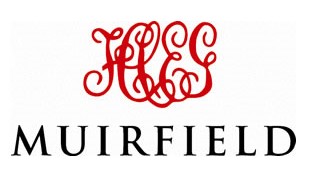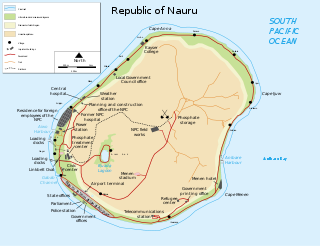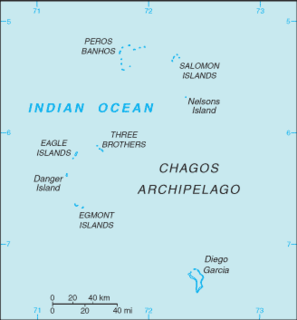| Muirfield Seamount | |
|---|---|
| Summit depth | 16–18 m (52–59 ft) |
| Height | ~5,000 m (16,404 ft) |
| Location | |
| Location | Indian Ocean |
| Coordinates | 13°13′30″S96°7′30″E / 13.22500°S 96.12500°E Coordinates: 13°13′30″S96°7′30″E / 13.22500°S 96.12500°E |
| Country | Australia (EEZ) |
| History | |
| Discovery date | 1973 |
The Muirfield Seamount is a submarine mountain located in the Indian Ocean approximately 130 kilometres (70 nautical miles) southwest of the Cocos (Keeling) Islands. The Cocos Islands are an Australian territory, and therefore the Muirfield Seamount is within Australia's Exclusive Economic Zone (EEZ). The Muirfield Seamount is a submerged archipelago, approximately 2.5 kilometres (1.6 miles) in diameter and 16–18 metre s (52–59 feet ) below the surface of the sea. A 1999 biological survey of the seamount performed by the Australian Commonwealth Scientific and Industrial Research Organisation (CSIRO) revealed that the area is depauperate.

A seamount is a mountain rising from the ocean floor that does not reach to the water's surface, and thus is not an island, islet or cliff-rock. Seamounts are typically formed from extinct volcanoes that rise abruptly and are usually found rising from the seafloor to 1,000–4,000 m (3,300–13,100 ft) in height. They are defined by oceanographers as independent features that rise to at least 1,000 m (3,281 ft) above the seafloor, characteristically of conical form. The peaks are often found hundreds to thousands of meters below the surface, and are therefore considered to be within the deep sea. During their evolution over geologic time, the largest seamounts may reach the sea surface where wave action erodes the summit to form a flat surface. After they have subsided and sunk below the sea surface such flat-top seamounts are called "guyots" or "tablemounts".

The Indian Ocean is the third-largest of the world's oceanic divisions, covering 70,560,000 km2 (27,240,000 sq mi). It is bounded by Asia on the north, on the west by Africa, on the east by Australia, and on the south by the Southern Ocean or, depending on definition, by Antarctica.

The Territory of Cocos (Keeling) Islands is an Australian external territory in the Indian Ocean, comprising a small archipelago approximately midway between Australia and Sri Lanka and closer to the Indonesian island of Sumatra. It is part of Southeast Asia and is in the Southern Hemisphere. The territory's dual name reflects that the islands have historically been known as either the Cocos Islands or the Keeling Islands.
Contents
The Muirfield Seamount was discovered accidentally in 1973 when the cargo ship MV Muirfield (a merchant vessel named after Muirfield, Scotland) was motoring in waters charted at a depth of greater than 5,000 metres (16,000 ft), when she suddenly struck an unknown object, resulting in extensive damage to her keel. [1] In 1983, HMAS Moresby, a Royal Australian Navy survey ship, surveyed the area where Muirfield was damaged, and charted in detail this previously unsuspected hazard to navigation.

Muirfield is a privately owned links which is the home of The Honourable Company of Edinburgh Golfers. Located in Gullane, East Lothian, Scotland, overlooking the Firth of Forth, Muirfield is one of the golf courses used in rotation for The Open Championship.

Scotland is a country that is part of the United Kingdom. It covers the northern third of the island of Great Britain, with a border with England to the southeast, and is surrounded by the Atlantic Ocean to the north and west, the North Sea to the northeast, the Irish Sea to the south, and more than 790 islands, including the Northern Isles and the Hebrides.

The keel is the bottom-most longitudinal structural element on a vessel. On some sailboats, it may be have a hydrodynamic and counterbalancing purpose, as well. As the laying down of the keel is the initial step in the construction of a ship, in British and American shipbuilding traditions the construction is dated from this event.
The dramatic accidental discovery of the Muirfield Seamount is often cited as an example of limitations in the vertical datum accuracy of some offshore areas as represented on nautical charts, especially on small-scale charts. More recently, in 2005 the submarine USS San Francisco (SSN-711) ran into an uncharted seamount about 560 kilometers (350 statute miles) south of Guam at a speed of 35 knots (40.3 mph; 64.8 km/h), sustaining serious damage and killing one seaman.

A nautical chart is a graphic representation of a sea area and adjacent coastal regions. Depending on the scale of the chart, it may show depths of water and heights of land, natural features of the seabed, details of the coastline, navigational hazards, locations of natural and human-made aids to navigation, information on tides and currents, local details of the Earth's magnetic field, and human-made structures such as harbours, buildings and bridges. Nautical charts are essential tools for marine navigation; many countries require vessels, especially commercial ships, to carry them. Nautical charting may take the form of charts printed on paper or computerized electronic navigational charts. Recent technologies have made available paper charts which are printed "on demand" with cartographic data that has been downloaded to the commercial printing company as recently as the night before printing. With each daily download, critical data such as Local Notices to Mariners are added to the on-demand chart files so that these charts are up to date at the time of printing.
Level of measurement or scale of measure is a classification that describes the nature of information within the values assigned to variables. Psychologist Stanley Smith Stevens developed the best-known classification with four levels, or scales, of measurement: nominal, ordinal, interval, and ratio. This framework of distinguishing levels of measurement originated in psychology and is widely criticized by scholars in other disciplines. Other classifications include those by Mosteller and Tukey, and by Chrisman.

USS San Francisco (SSN-711) is a Los Angeles-class nuclear submarine, the third ship or boat of the United States Navy to be named for San Francisco, California.













